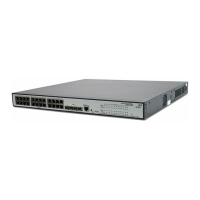324 CHAPTER 30: CLUSTER
which case the management device considers the member device
disconnected. Likewise, if this member device, which is in Connect state,
receives a handshake packet or management packet from the management
device within the information holdtime, it changes its state to Active;
otherwise, it changes its state to Disconnect.
■ If the connection between the management device and a member device in
Disconnect state is recovered, the member device will be added to the cluster
again. After that, the state of the member device will turn to Active both locally
and on the management device.
Besides, handshake packets are also used by member devices to inform the
management device of topology changes.
Additionally, on the management device, you can configure the FTP server, TFTP
server, logging host and SNMP host to be shared by the whole cluster. When a
member device in the cluster communicates with an external server, the member
device first transmits data to the management device, which then forwards the
data to the external server. The management device serves as the default shared
FTP server when no shared FTP server is configured for the cluster.
Management VLAN
Management VLAN limits the range of cluster management. Through
management VLAN configuration, the following functions can be implemented:
■ Enabling the management packets (including NDP packets, NTDP packets, and
handshake packets) to be transmitted in the management VLAN only, through
which the management packets are isolated from other packets and network
security is improved.
■ Enabling the management device and the member devices to communicate
with each other in the management VLAN.
Cluster management requires the packets of the management VLAN be permitted
on ports connecting the management device and the member/candidate devices.
Therefore:
■ If the packets of management VLAN are not permitted on a candidate device
port connecting to the management device, the candidate device cannot be
added to the cluster. In this case, you can enable the packets of the
management VLAN to be permitted on the port through the management
VLAN auto-negotiation function.
■ Packets of the management VLAN can be exchanged between the
management device and a member device/candidate device without carrying
VLAN tags only when the default VLAN ID of both the two ports connecting
the management device and the member/candidate device is the management
VLAN. If the VLAN IDs of the both sides are not that of the management VLAN,
packets of the management VLAN need to be tagged.
n
■ By default, the management VLAN interface is used as the network
management interface.
■ There is only one network management interface on a management device;
any newly configured network management interface will overwrite the old
one.

